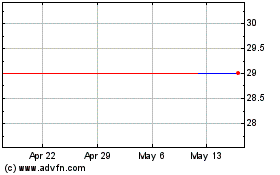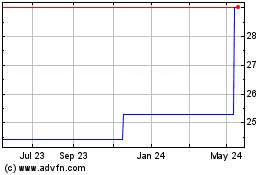Japanese Stocks Fall to Lowest Levels in More Than a Year
February 11 2016 - 8:50PM
Dow Jones News
Japanese stocks plummeted Friday morning, plumbing their lowest
level in more than a year and leading Asian markets down after a
selloff in U.S. and Europe overnight.
Japan's benchmark Nikkei was down 3.7% after a holiday on
Thursday, its lowest level since October 2014. Australia's
S&P/ASX 200 was down 0.9%. New Zealand's NZX50 was down
1.2%.
Japan shares are also headed for their worst weekly drop in
almost five years. The market is down 21% for the year, a decline
almost as steep as the losses in Chinese stocks. The Nikkei's loss
this morning is putting the benchmark on track to lose almost 10%
for the week, marking the worst percentage performance since the
week ended March 18, 2011.
"The leads for Asia have once again centered on European banks
and shenanigans in the oil complex," Chris Weston, chief market
strategist at IG in Melbourne, said.
The Federal Reserve's cautious stance on further rate increases
raised doubts about the global economy and led to the yen's sharp
rise against the dollar. The dollar was at 112.23 yen after falling
to ¥ 110.99 on Thursday, the lowest level since Oct. 31, 2014, the
day the Bank of Japan expanded its easing program.
Japanese Finance Minister Taro Aso said Friday morning the yen's
moves have been rough and that rapid moves in the foreign exchange
market aren't desirable. He said he would watch foreign exchange
markets with close interest.
The yen and government bonds tend to appreciate in times of
economic uncertainty. The benchmark 10-year Japanese government
bond yield was flat at 0.005%.
Early weakness in Asia was tempered by some signs of stability
in U.S. stocks on Thursday, as they pared steep losses in
late-afternoon trading, and a surge in crude-oil prices, which
clawed back from a fresh multiyear low in after-hours trading.
Sweden's central bank on Thursday cut its main interest rate
further into negative territory, a move judged more aggressive than
anticipated by markets as the Riksbank adds to a small but growing
number of central banks willing to test the boundaries of how low
interest rates can go.
Oil inflamed the wide equities selloff as crude prices settled
at their lowest levels since 2003 amid worries about growing
stockpiles in the U.S. and about financial markets. Oil staged a
recovery after U.S. prices settled down 4.5% at US$26.21 a barrel,
while Brent crude declined 2.5% to US$30.06.
Australian shares opened in the red, with bank and energy stocks
leading the decline. The Australian market entered a technical bear
market this week, marked by a 20% fall from its high last year, but
recovered 1% on Thursday as major banks rebounded from a global
banking selloff in recent sessions.
"Recurring nightmares continued overnight with price action poor
and flight-to-safety flows dominating," Australia & New Zealand
Banking Group said in a report to clients. "Gone are the days where
bad news was good as it portended of more dovish central banks and
more cheap money on offer."
It said some of the anxiety was likely chalked up to delayed
disappointment in testimony by U.S. Federal Reserve Chairwoman
Janet Yellen as she juggled recognizing strength in the domestic
economy and potential risks of heightened financial market
volatility. On Thursday, she said the U.S. central bank was
studying the feasibility of pushing short-term interest rates into
negative territory should it need to give the economy an added
boost, which would join central banks in Europe and Japan.
On Thursday, the Dow Jones Industrial Average declined 255
points, or 1.6%, to 15660. The S&P 500 fell 1.2% and the Nasdaq
Composite lost 0.4%. The Stoxx Europe 600 fell 3.7% to its lowest
close since 2013, and the U.K.'s FTSE 100 closed at its lowest
level since July 2012.
At the same time, investors sought safety, with U.S. government
bonds, the yen and gold surging. Gold futures jumped by more than
$50 an ounce to settle at the highest level in about a year at
$1,247.80.
Write to Kosaku Narioka at kosaku.narioka@wsj.com
(END) Dow Jones Newswires
February 11, 2016 20:35 ET (01:35 GMT)
Copyright (c) 2016 Dow Jones & Company, Inc.
Australia And New Zealan... (ASX:ANZCD)
Historical Stock Chart
From Dec 2024 to Jan 2025

Australia And New Zealan... (ASX:ANZCD)
Historical Stock Chart
From Jan 2024 to Jan 2025
